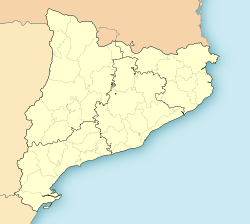Besalú facts for kids
Quick facts for kids
Besalú
|
|||
|---|---|---|---|
|
Municipality
|
|||
 |
|||
|
|||
| Country | |||
| Community | |||
| Province | Girona | ||
| Comarca | Garrotxa | ||
| Area | |||
| • Total | 4.9 km2 (1.9 sq mi) | ||
| Elevation | 151 m (495 ft) | ||
| Population
(2018)
|
|||
| • Total | 2,467 | ||
| • Density | 503/km2 (1,304/sq mi) | ||
| Demonym(s) | Besaluenc | ||
Besalú is a charming town located in the Garrotxa region of Catalonia, Spain. It's a place where history comes alive, especially with its amazing medieval bridge and ancient buildings.
This town was super important way back in the Middle Ages. It was the capital of the county of Besalú, which was a powerful area. Even Wilfred the Hairy, a famous leader who helped unite Catalonia, was a Count of Besalú! The town was also home to Raimon Vidal, a medieval poet and musician called a troubadour.
In 1966, Besalú was officially named a "historical national property." This means it's a special place protected for its history and art. Its most famous landmark is the incredible 12th-century Romanesque bridge over the Fluvià river. This bridge even has a cool gateway in the middle! You can also find old churches, arcaded streets, and a restored mikveh, which is a special Jewish bath from the 11th or 12th century. There are also remains of a medieval synagogue near the river. If you love tiny things, check out the Museum of Miniatures, created by Lluís Carreras.
Contents
A Glimpse into Besalú's Past
The name Besalú comes from the Latin "Bisuldunum," which means "a fort on a mountain between two rivers." It was once the main town of the "La Garrotxa" area. A key moment in its history was in 894, when Besalú became its own county with its own ruling family.
Later, in 1111, Besalú lost its independence and became part of the County of Barcelona. Over the centuries, the town faced tough times, including wars. But in 1966, Besalú was recognized as a site of great historical and artistic importance, helping to preserve its unique heritage.
Exploring Besalú's Amazing Sights
Besalú is surrounded by parts of its ancient walls, built between the 12th and 14th centuries. Even though only parts remain, the town's layout is still very similar to how it was long ago.
The Iconic Medieval Bridge
Without a doubt, the most famous symbol of Besalú is its amazing medieval bridge. It has a unique angled design with seven arches that are all different sizes, plus two towers. It's a fantastic spot for photos!
The Historic Jewish Quarter
Near the bridge, you'll find many narrow streets that were once part of the old Jewish quarter. This area is home to the Miqvé, a special purification bath from the 12th century. It shows that an important Jewish community lived here. This is the only Romanesque mikvah still left in Spain!
Town Square and Important Buildings
The street from the medieval bridge leads to the main Town Square, called "Plaça Major." This square has beautiful arcades from the 16th century and used to be the heart of the medieval town.
Important buildings around town include the "Ajuntament" (Town Hall) from the 17th century, the "Cúria Reial" (Royal Court) from the 14th century, and the "Casa Tallaferro."
Castle and Churches
The "Tallaferro" street takes you to the old Castle area. Here, you can still see one of the towers from the ancient County Castle and the apse (a rounded part) of the Saint Mary church from the 11th century. These spots, along with "Portalet" street, really make you feel like you've stepped back in time, and they offer great views of the Roman Bridge.
Walking up from the main street, "Carrer Major," you'll find the "Casa Romà" (14th century) and the parish church of Saint Vincent ("Sant Vicenç"). This church, from the 11th-12th centuries, has beautifully carved doors and windows.
Near the main Town Square is "Prat de Sant Pere," a wide open space that used to be the cemetery for the Benedictine monastery of Saint Peter ("Sant Pere"). Today, you can still see the three-nave church and one apse from the 11th century. There's also the small chapel of Saint James ("Sant Jaume") from the 12th century and the "Casa Cornellà" (also known as Llaudes) from the 12th century, which has a lovely patio with three galleries. Behind the monastery is the church of the hospital of Saint Julian ("Sant Julià"), from the 12th century, with a striking entrance.
Images for kids
See also
 In Spanish: Besalú para niños
In Spanish: Besalú para niños








